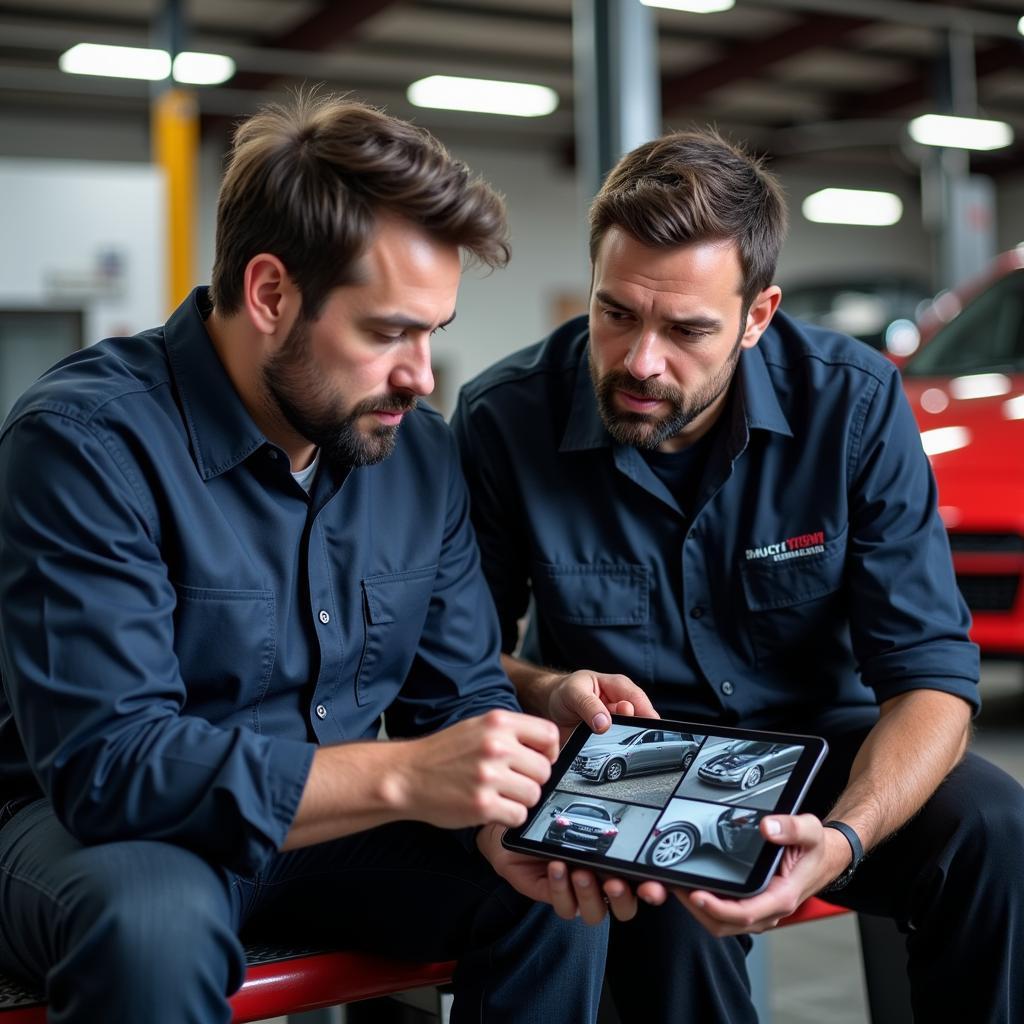Paint bubbles on your car are unsightly and can lead to more serious problems if left untreated. They signal a breakdown in the paint’s adhesion to the underlying surface, and understanding how to fix them is crucial for maintaining your car’s appearance and value. This guide will walk you through the causes and provide a step-by-step solution on How To Fix Paint Bubbles On Car.
Fixing paint bubbles isn’t always a DIY job, but with the right tools and patience, you can often tackle smaller areas yourself. Before we dive into the “how-to,” let’s understand why these bubbles form in the first place. Common culprits include moisture getting trapped under the paint, poor surface preparation before painting, or exposure to harsh chemicals. Sometimes, even a minor impact can cause bubbles to appear later on. how to fix a broken car door hinge can sometimes involve repainting, which, if done incorrectly, can lead to bubbling.
Identifying the Cause of Your Car’s Paint Bubbles
Knowing the root cause is the first step to an effective repair. Is it rust bubbling up from underneath? Did the previous paint job trap moisture? Or was it a reaction to a harsh cleaning product?
Moisture: A Common Culprit
Moisture is a frequent offender, often sneaking in through tiny chips or cracks in the paint. This trapped moisture then expands and contracts with temperature changes, creating pressure that lifts the paint, forming bubbles.
Poor Surface Preparation
Another common reason is inadequate preparation before painting. If the surface wasn’t properly cleaned and primed, the new paint won’t adhere correctly, leading to bubbles.
Impact Damage
Sometimes, a small rock chip or even a minor ding can cause paint bubbles. The impact can damage the paint layers, allowing moisture to seep in.
How to Fix Those Pesky Paint Bubbles
Once you’ve identified the cause, you can begin the repair process.
- Gather Your Supplies: You’ll need sandpaper (various grits), primer, touch-up paint, clear coat, a scraper, masking tape, and rubbing compound.
- Prepare the Area: Clean the area thoroughly with soap and water. Then, using the scraper, carefully remove the loose paint and bubbles.
- Sand the Affected Area: Start with a coarser grit sandpaper to smooth out the edges and remove any remaining loose paint. Gradually move to a finer grit for a smooth finish. This is also a good opportunity to check for how to fix loose trim on car if you find any issues around the bubbling area.
- Apply Primer: Prime the bare metal to prevent rust and provide a better surface for the paint to adhere to.
- Apply Touch-Up Paint: Once the primer is dry, carefully apply thin coats of touch-up paint, allowing each coat to dry completely before applying the next.
- Apply Clear Coat: After the final coat of paint is dry, apply a clear coat to protect the paint and give it a glossy finish.
- Sand and Buff: Once the clear coat is dry, use fine-grit sandpaper to smooth out any imperfections. Follow up with a rubbing compound to restore the shine. Looking for easy stuff to fix on a car? This might be a good starting point if the damage is minimal.
Preventing Future Paint Bubbles
Prevention is always better than cure. Regular washing and waxing can help protect your car’s paint. Addressing minor chips and scratches promptly can also prevent moisture from getting in. Wondering can you pay to fix interior of car? Absolutely! For larger or more complex paint repairs, it’s often best to consult a professional.
“A good quality primer is essential for a lasting paint repair,” says automotive expert, Michael Davis. “It provides a solid foundation and prevents future bubbling.”
How To Fix Small Paint Bubbles on Your Car
Smaller bubbles can often be addressed with a touch-up paint pen or kit. Just be sure to clean the area thoroughly before applying the paint.
“Don’t underestimate the importance of surface preparation,” advises Sarah Miller, an experienced auto body technician. “A clean, smooth surface is key to a successful paint repair.”
Conclusion
Fixing paint bubbles on your car requires patience and attention to detail. By following these steps, you can restore your car’s appearance and protect it from further damage. Remember, early intervention is key. Addressing minor bubbles before they spread can save you time and money in the long run. If you need professional assistance or have further questions about how to fix paint bubbles on car, feel free to connect with us at AutoTipPro. You can reach us at +1 (641) 206-8880 or visit our office at 500 N St Mary’s St, San Antonio, TX 78205, United States.
FAQ
- Can I use any type of primer? No, use an automotive primer designed for your car’s paint type.
- How long should I wait between paint coats? Follow the instructions on the paint can for drying times.
- What if the bubbles keep coming back? There might be underlying rust or moisture issues that need to be addressed.
- Can I wax my car after fixing paint bubbles? Yes, after the clear coat has fully cured (usually a few weeks).
- Is it difficult to match the paint color? Most auto parts stores can help you find the correct paint code for your car. how to fix car squeaking can be a separate but important concern, so remember to check for that too.
- What if the bubbles are over a large area? For extensive damage, it’s best to consult a professional auto body shop.
- What tools do I need to fix paint bubbles on my car? You’ll need sandpaper, primer, touch-up paint, clear coat, a scraper, masking tape, and rubbing compound.





Leave a Reply